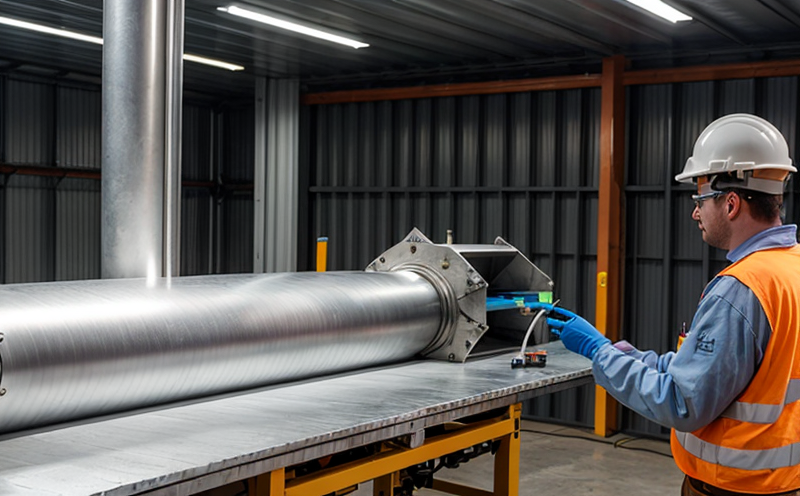ASTM D7136 Impact Resistance Testing of Renewable Composites
The ASTM D7136 test method is a critical procedure used to evaluate the impact resistance properties of renewable composite materials. This standard provides a standardized approach for determining how well these materials withstand sudden impacts, which is particularly important in energy and renewable applications where durability is paramount.
Renewable composites encompass a wide range of materials including bio-based polymers, lignin-based plastics, and other plant-derived substances. These materials are becoming increasingly popular due to their reduced environmental impact compared to traditional petroleum-based composites. However, they often possess lower mechanical properties than conventional materials, making impact resistance testing especially relevant.
The ASTM D7136 test involves subjecting specimens of the renewable composite material to controlled impacts using a falling weight or pendulum device. The specimen is positioned on a support fixture and struck by a free-falling weight. The energy absorbed by the material during this impact provides insight into its resistance to damage.
The testing process begins with precise preparation of the specimens, ensuring they are representative of the actual components in use. This involves cutting the composite materials to specified dimensions as outlined in ASTM D7136. The specimens must be free from defects and prepared according to the standard’s requirements to ensure accurate test results.
The testing apparatus used for this procedure is typically a Charpy impact tester, which can be configured with different pendulum weights depending on the material being tested. This flexibility allows for tailoring the test conditions to the specific properties of the renewable composite. The impact energy absorbed by the specimen during the test is measured using a calibrated sensor.
Post-test analysis involves examining any cracks or fractures formed in the specimens. Visual inspection and more detailed techniques such as X-ray radiography can be employed if necessary. The amount of energy required to cause visible damage serves as an indicator of the material's impact resistance.
The ASTM D7136 test is not just a laboratory exercise; it plays a crucial role in ensuring that renewable composite materials meet stringent quality and reliability standards. By incorporating this testing into their product development process, manufacturers can identify potential weaknesses early on and make necessary adjustments to improve the material's performance.
This testing method helps establish trust among stakeholders by providing objective data that can be used during compliance audits or certification processes. It also supports continuous improvement efforts within R&D departments by offering insights into how different formulations affect impact resistance.
Benefits
The ASTM D7136 impact resistance testing offers numerous benefits, particularly for manufacturers and developers of renewable composite materials. One key advantage is enhanced product quality assurance. By subjecting specimens to controlled impacts, potential weaknesses in the design or composition can be identified early in the development cycle.
Another significant benefit lies in meeting regulatory requirements. Many industries have strict standards that must be adhered to for both safety and environmental reasons. ASTM D7136 provides a reliable means of demonstrating compliance with these regulations, which is crucial for market entry and maintaining good standing with customers and regulators.
From an operational perspective, implementing this testing procedure leads to reduced downtime and increased efficiency in production processes. Identifying issues early through impact resistance tests allows companies to address them promptly rather than discovering problems after the product has been released into the market.
The test also facilitates better decision-making by providing actionable data that can influence material selection, process optimization, and overall design improvements. This knowledge is invaluable for R&D teams looking to innovate within their field while staying competitive in terms of sustainability practices.
Quality and Reliability Assurance
The ASTM D7136 impact resistance test plays a vital role in ensuring the quality and reliability of renewable composite materials. In an era where environmental consciousness is growing, it's essential that these materials not only perform well but also last under harsh conditions without compromising safety.
By subjecting specimens to controlled impacts, this testing method helps identify any flaws or weaknesses that might otherwise go unnoticed until the product reaches end-users. Early detection allows for corrective actions such as adjusting manufacturing processes or reformulating materials before they impact customer satisfaction negatively.
The reliability aspect comes into play when considering long-term performance expectations of renewable composites in various applications, from wind turbine blades to automotive components. Ensuring consistent quality across batches is crucial not only for maintaining brand reputation but also for protecting consumer trust and safety.
Compliance with international standards like ASTM D7136 adds credibility both domestically and internationally. It reassures clients that the products meet recognized benchmarks, thereby fostering confidence in the marketplace.
Competitive Advantage and Market Impact
Incorporating ASTM D7136 impact resistance testing into your quality assurance program can provide significant competitive advantages. As sustainability becomes a core focus for many businesses, demonstrating leadership in this area through rigorous testing can set your products apart from competitors.
Customers increasingly seek out eco-friendly solutions that not only meet but exceed expectations regarding durability and performance. By showcasing compliance with ASTM D7136, you signal commitment to both sustainability and quality assurance, which can be compelling selling points in marketing materials and discussions with potential partners or clients.
The test results from ASTM D7136 impact resistance can also serve as a benchmark for internal performance metrics. They enable companies to measure progress over time, track improvements made through R&D initiatives, and compare their offerings against industry leaders.
Moreover, having robust data on the impact resistance properties of your renewable composite materials can open doors to new markets or applications where stringent requirements exist. For example, in sectors like aerospace or offshore wind energy, there is a premium placed on materials that can withstand extreme conditions without failure.





